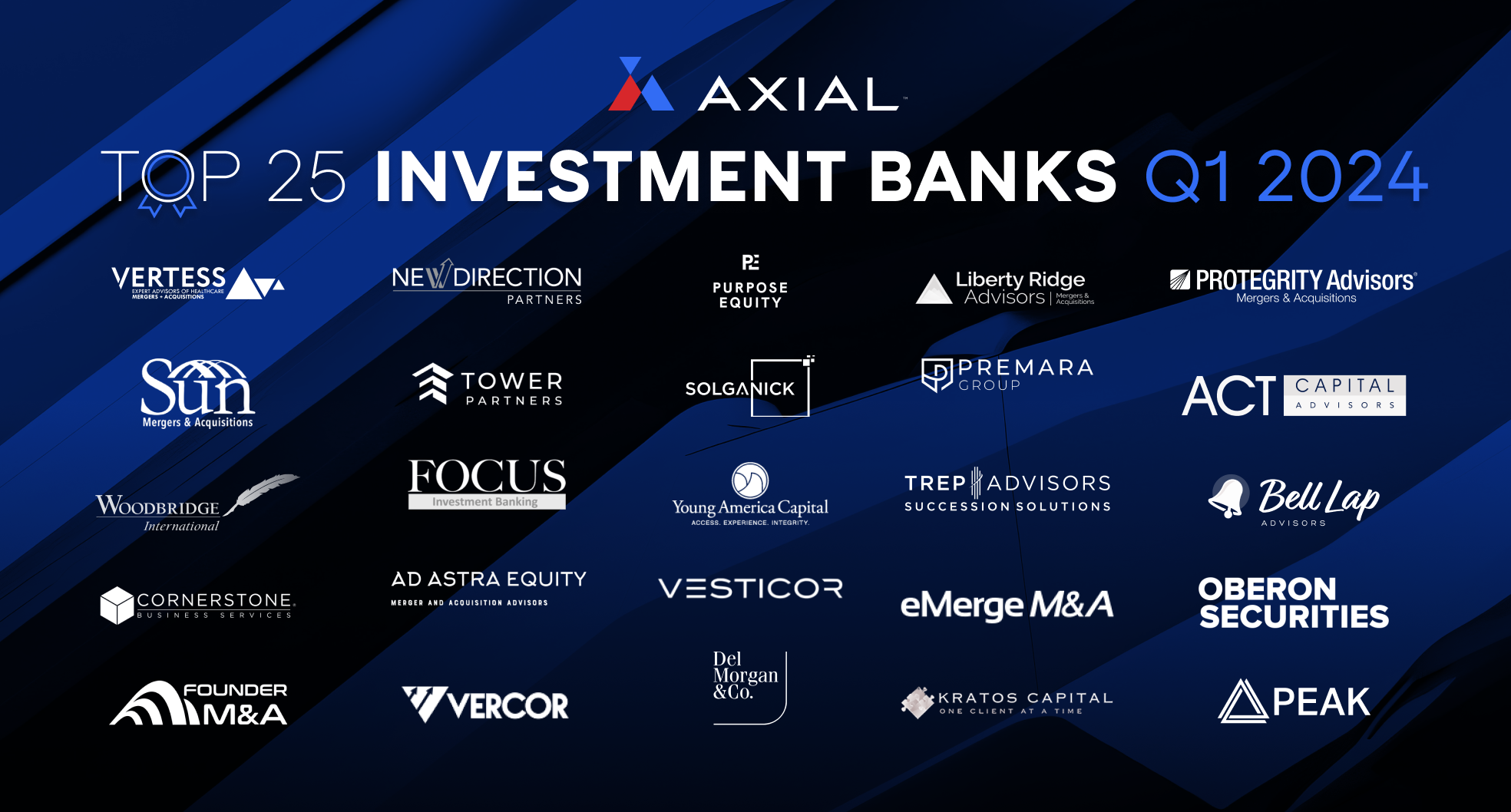
Top 25 Lower Middle Market Investment Banks | Q1 2024
Axial is excited to release our Q1 2024 Lower Middle Market Investment Banking League Tables. To assemble this list, we…
Advisors, Buyers, Private Equity
Tags
Uncertainty has plagued healthcare organizations and investors ever since Donald Trump’s election in 2016.
“There was a lot of angst, and rightfully so, about how efforts to repeal and replace the Affordable Care Act were going to disrupt the interest in healthcare M&A,” says Dexter Braff, president of Pittsburgh-based healthcare investment bank The Braff Group. While the administration wasn’t able to repeal the ACA as hoped, “they did do a lot of damage to it” by eliminating or changing various provisions through executive order.
“But now we’re 18 months into his presidency, and we can weigh in on the impact — and it’s been minimal. The fear that the election was going to totally upend buyer’s confidence in the sector did not come to play. The reason for that is much of what has driven the recent surge in health care M&A — namely a shift from fee-for-service to value-based care that requires greater coordination of services and therefore favors strategic acquisitions — remains firmly in place,” says Braff.
The shift to value-based care has spurred changes across a broad spectrum of healthcare organizations and provided new opportunities for private equity and other investors to add value. In a fee-for-service model, providers are reimbursed based on the number of services they provide. “Value-based care simply says, rather than incenting the physician to simply prescribe more procedures, let’s have the providers be responsible for the patient’s health,” says John Selig, managing partner of WaveEdge Capital, an investment bank based in Woodside, CA.
Healthcare M&A reached record highs in 2017, with 115 total transactions, according to management consulting firm Kaufman Hall. We talked to three senior investment bankers to get their take on the hottest healthcare subsectors in the middle market today.
“Behavioral health in general has skyrocketed in the last 12 months,” says Braff. “Part of this is because under the Affordable Care Act, insurance companies are mandated to provide behavioral health services on par with what they offer on medical services.” While insurance companies continue to fight the mandate, “the opportunity for growth and expansion of insurance benefits within behavioral health programs portends increased utilization and has led to a substantial increase in the amount of money flowing into the space, particularly from private equity.”
Braff says the single hottest subsector in behavioral health right now is autism services — including clinics, at-home services, and programs under school contracts. “The space has been growing geometrically in the last couple of years due in large part to expansion of mandated insurance coverage to nearly every state across the country.”
Not only is there increased funding, but there is also increased utilization. Whereas providers once served individuals in elementary school through high school, “now they’ve providing services for individuals from two or three years old into their twenties,” says Braff.
“If there was a signal to the marketplace about where autism services sits in the investment world, this is it.”
In April, Blackstone (NYSE: BX) announced it would acquire autism services provider Center for Autism and Related Disorders (CARD) for an undisclosed amount, investing alongside current founder and chief executive Doreen Granpeesheh. “If there was a signal to the marketplace about where autism services sits in the investment world, this is it,” says Braff. “Blackstone normally wouldn’t look at something as small as CARD — even though CARD is the largest provider in the space. But autism is a very very hot space, carrying valuations that are almost de facto greater than 10X, even for small providers with earnings as low as a million or less.”
“Private equity has been significantly active in the physician practice management sector over the last couple of years. They’ve taken very fragmented businesses and scaled them up, with some very successful exits in a number of different sectors,” says Rajesh Kothari, managing director with Michigan-based private equity firm Cascade Partners.
“Eye care has just exploded.”
In particular, “eye care has just exploded,” says Kothari. Vision care is a $36 billion industry in the U.S. His firm represented Grand Rapids Ophthalmology in their partnership with Chicago-based private equity firm Sterling Partners in February 2017, and is currently representing two eye care practices considering private equity. “Today, there are probably north of 20 private equity groups that have acquired eye care platforms in a year. I’ve never seen anything like it.”
Changes in the business of healthcare are in part driving PE’s strong interest in eye care, as well as other physician practice management segments including emergency medicine, gastroenterology, podiatry, dermatology, dental, and women’s health.
With pressure to invest in IT systems and comply with new regulations, “the cost of healthcare has gone up for physicians,” says Kothari. Private equity firms can provide the scale and capital needed to make acquisitions, improve back-office efficiency, and add analytics and insight into the practices that doctors just don’t have. “I joke all the time, ‘People can be fantastic physicians, and they can be fantastic executives. But those are both full-time jobs,’” says Kothari.
Eye care in particular is also relatively immune to economic fluctuations. “If your eyes go bad you’re going to do see the doctor. It’s not one of those things you’ll cut back on. Private equity loves the consistent nature,” says Kothari. “In addition, eye care offers multiple revenue streams and ways to develop businesses for savvy private equity firms. A practice might be expanded to include not only ophthalmology but also optometry, ambulatory surgery, and retail. These businesses are highly fragmented and have not focused on efficiency, which plays very well to private equity.”
The demand for vision services from an aging population is also outpacing the supply of ophthalmologists. According to a report by Cascade Partners, by 2020 it is expected there will be a 30% shortage of ophthalmologists. In addition, an increasing number of baby boomer physicians are retiring. “The next generation isn’t as interested in ownership. Many of them have a million dollars of medical school debt. The last thing they want to do is buy a practice,” says Kothari.
Digital health — and in particular telehealth, remote monitoring, and digital therapies — is another hot sector, in large part again due to the shift to value-based models of care.
“What’s the most expensive thing that can happen to a patient? Getting hospitalized. It’s also — not coincidentally — the worst thing that can happen to a patient. By the time you have to go to the hospital, it’s because you’re really sick,” says Wave Edge’s Selig. An increasing array of digital health solutions are attempting to stave off unnecessary emergency room visits and improve patients’ health outcomes overall.
“Frequent, customized, high-touch interactions with the patient — by an MD, a nurse, a PA, a regular caregiver, or even a digital avatar — can make sure the patient is managing their disease and encourage them to modify their behavior. The physician is incented to implement these solutions, in part because it helps patients, but also because they can increase their compensation. And the payor, the third stakeholder, is also happy because instead of jamming more procedures in, there’s a focus on getting the most bang for your buck,” says Selig.
For example, WaveEdge represented Mango Health (a Kleiner Perkins portfolio company), which uses gamification to help patients adhere to their medications schedule, in a strategic partnership transaction. “Mango Health is all about making it interesting and engaging for the patient to continue to be compliant, which of course is good for the pharma companies, but it’s actually really good for the patient and payor as well.”
Mobile health is also a growing segment. For example, iMedrix (a WaveEdge client) provides a fully mobile electrocardiogram (ECG) for patients — “instead of having the ECG sitting in an expensive box in an ICU, it’s a much cheaper, faster, fully mobile device that’s just as accurate and can take a patient’s ECG when he or she is fully clothed within 30 seconds. Hospital systems are using it throughout India, southeast Asia, the Middle East, and other regions right now,” says Selig.
“For digital health, the key is to invest in solutions that are not just sexy, but also cost-effective,” says Selig. “We are seeing very good valuations for companies like iMedrix that are in market and are validated solutions.”
